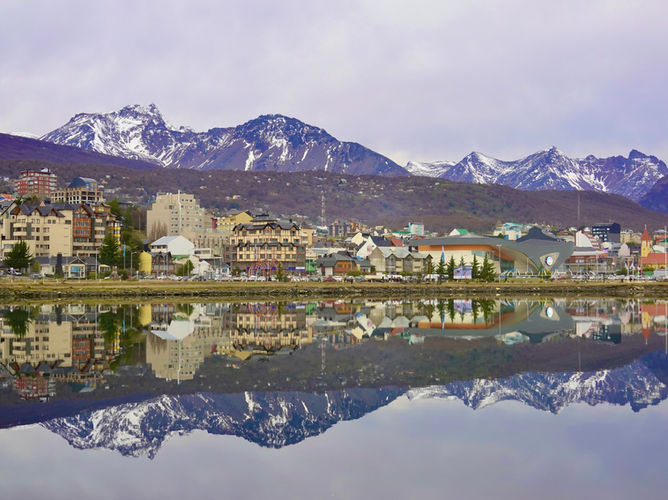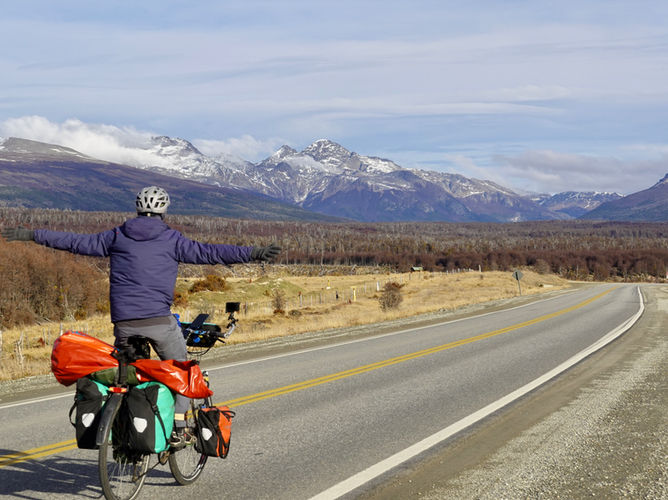
Argentina
Last updated: December 2023
Overview:

If you are finding our content useful,
we would appreciate a donation via PayPal!
Key Facts Cycling
-
18 days in the country, from 24/02/2023 to 26/02/203 ; 11/03/2023 & 06/05/2023 to 22/05/2023
-
308 km / 191 mi cycled
-
Three cycling days
-
Overnight stays:
-
Wildcamping: 1
-
Other free camping (villages, etc.): 1
-
Paid campsites: 1
-
Hosts: 0
-
Paid accommodation: 16 (13 nights in Ushuaia)
-
Other (bus, ferries, etc.): 0
-
-
The Route: San Sebastián - Río Grande - Tolhuin - Ushuaia
-
In February / March 2023 we had a bike free two-week-vacation in Buenos Aires & Uruguay with Louisa's parents (Return flight Santiago - Buenos Aires)
-
Our Cycling Highlights: Tierra del Fuego (the only part in Argentina that we cycled)
Note: On this page you will mostly find general information about Argentina. If you want to learn more about cycling Patagonia & Tierra del Fuego click here.
Key Facts Country
-
Official name: Argentine Republic
-
Population (2023): 46,621,847
-
Capital: Buenos Aires
-
Official language: Spanish
-
Currency: Argentine Peso (ARS)
-
Dialing code: +54
-
Covers 2,780,400 km² / 1073518 mi², making it the second largest country in South America & eighth largest in the world
-
Bordering countries: Chile, Bolivia, Paraguay, Brazil & Uruguay
-
One of the most biodiverse countries in the world, hosting one of the greatest ecosystem varieties in the world: 15 continental zones, two marine zones and the Antarctic region
-
Right-hand traffic
Camping & Accommodation
-
In the Argentine part of Tierra del Fuego there are no refugios (shelters) provided, apart from the one at the border crossing San Sebastián
-
Wild camping in Tierra del Fuego is difficult due to the vast open landscapes that don't provide any kind of shelter from the strong winds
-
Once you get into the more mountainous region in the south of TdF, wild camping becomes a bit easier
-
You can check iOverlander for spots to camp
-
Many villages/towns offer some type of accommodation
-
In Ushuaia we stayed almost two weeks in an affordable apartment (~16 EUR/night) a few kilometers from the center
Infrastructure
-
Argentina generally has good infrastructure
-
The roads we cycled in Tierra del Fuego were nicely paved
-
The tap water in most of the country is potable; we always carry chlorine tablets to disinfect water if necessary though
-
Options for leaving (or arriving in) Ushuaia:
-
Fly out (or in) via Ushuaia International Airport Malvinas Argentinas / Tierra del Fuego - Argentina (USH)
-
Take a bus to Rio Gallegos (AR) or Punta Arenas (CL):
-
Tecni Austral - we went with this company from Ushuaia to Punta Arenas and everything went well
-
-
Take a ferry from Puerto Williams to Punta Arenas
-
Company: Transbordadora Austral Broom
-
Puerto Williams is a Chilean village on the southern shore of the Beagle Channel
-
To take the ferry, you first have to take another boat from Ushuaia to Puerto Navarino and then a van ride Puerto Williams (usually combined in one offer)
-
In May 2023, we’ve been told that these connections still weren’t offered due to Covid-19
-
It seems like there are some options again now, but the price starts at 120 USD per person
-
We met some other travelers (two of them cyclists) who organized themselves a crossing with a private boat, which also cost them over 120 USD per person
-
-
Spare Part Availability
-
Outside of bigger towns you probably won’t encounter any bike shops
-
El Calafate, Río Gallegos & Río Grande have a few good looking shops (judging from photos, we didn't visit any of these towns)
-
In Ushuaia you'll find some bike shops as well
-
At Home Bike we bought several spare parts and had some parts of our drive trains changed
-
We also got two bike boxes from DTT for the bus ride to Punta Arenas and the flight to Australia
-
Sim Card & Internet
-
Network providers: Claro, Movistar & Personal
-
We didn’t buy a sim card in Argentina, so we can’t speak from experience
-
Claro seems to be a good option especially for Patagonia; apparently there is even good connection in rather remote parts of the region
Climate & Weather
-
Due to it’s massive size, Argentina boasts lots of different climate zones & habitats
-
Four general climate zones:
-
Warm & humid
-
Moderate
-
Arid
-
Cold
-
-
Four seasons, becoming more distinctive the further south you go:
-
Spring (September - November)
-
Summer (December - February)
-
Autumn (March - May)
-
Winter (June - August)
-
-
We visited Buenos Aires in February/March and it was incredibly hot and humid there
-
We stayed in Ushuaia for three weeks in May and it was cold, often around 0°C / 32°F, but we didn’t have snow (unfortunately, that would have been nice)
Border Crossings
-
Chile to Argentina: San Sebastián - fast & easy (this border has a warm waiting room where cyclists can spend the night!)
-
Airport Buenos Aires: Ezeiza International Airport
-
Argentina to Uruguay (round trip):
-
Ferry Buenos Aires - Colonia del Sacramento with Buquebus
-
Ferry Montevideo - Buenos Aires with Buquebus
-
-
These are only the border crossings we took, there are of course many more
-
With our German passports we got 90 days without having to apply for a visa
-
No costs
-
Always check regulations before entering the country as they might change on short notice
Safety
-
Generally we felt safe, but we always try to stay hidden when camping
-
Big cities are potentially more dangerous, just be cautious and inform yourself about areas you better avoid; we didn't have any dangerous situations
-
In Buenos Aires we were warned about pickpockets, especially in the touristy areas
-
We didn’t have any dog problems, but we only cycled a few days in Argentina, so we can’t speak for most of the country
-
Only on the last part between Río Grande and Ushuaia we were often overtaken carelessly with too little distance and too much speed
-
Emergency numbers:
-
Central Emergency number (Central de Emergencias Nacional): 911
-
Ambulance (SAME): 107
-
Firefighters (Bomberos): 100
-
Cash & Expenses
-
Argentina had an inflation of over 100% when we were there (May 2023)
-
Two rates:
-
Official rate, applies when you pay with card
-
Exchange rate Oct. 2023: 1 EUR = 369 ARS / 1 USD = 350 ARS
-
-
Unofficial blue rate:
-
This rate applies when you exchange USD (or EUR) for the ARS
-
In May 2023 we got twice the amount of ARS compared to the official rate, so you can save a lot of money
-
You even get this rate when sending money for cash pickup via WesternUnion (which we can definitely recommend)
-
Blue exchange rate Oct. 2023: 1 EUR = 1,030 ARS / 1 USD = 975 ARS
-
Means you have to carry huge packs of cash around with you though
-
-
-
ATMs are called Cajero Automático in Spanish
Tourism
-
Nationalpark Los Glaciares, Argentina:
-
One of Argentina’s biggest tourist attractions
-
Features several glaciers that originate in the great Patagonian Ice Field, the second largest ice sheet in the world (after Antarctica), which occupies almost half of the Park
-
Highlights:
-
Glacier Perito Moreno, accessible from El Calafate
-
Mount Fitzroy, accessible from El Chaltén
-
-
Entry fee (Oct. 2023): 12,000 ARS
-
Opening times:
-
Summer (01. Sept. - 30. Apr.): 8 am to 6 pm
-
Winter (01. May - 31. Aug.): 9 am to 4 pm
-
-
-
Ushuaia:
-
'El Fin del Mundo' / 'The End of the World'
-
A touristy, but nice town
-
Depending on the season, you can do different (boat) tours in the area
-
May 2023: We did a boat tour in the Beagle Channel and were lucky to see several humpback whales (even though it wasn't a designated whale watching tour)
-
We stayed two weeks in a really affordable Airbnb, 3 km from the center
-































